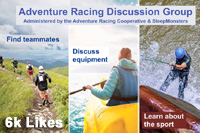European Adventure Race Finals
From Waterford to Ballyhoura - The 2015 European Championships Course.
Rob Howard / 29.07.2015


When the route book and maps were given out at the start of this afternoons race briefing it was no great surprise that the start of the race would be in Waterford, Ireland’s oldest city.
This news had leaked out ahead of the race, ending a lot of enjoyable speculation during which many had expected the course to go further west. They were wrong and the start will be at Curraghmore House on Lord Waterford’s estate, starting with a marked 18km trail run at 8.00 tomorrow morning. This will take teams to the River Suir for the first paddling stage of what will be a wet and coastal start to the race.
Before looking at the route in more detail the bigger picture is that there are no cut-offs and no dark zones in this race, which is run on a score format with points given for each checkpoint reached within the 72 hour time limit. (Any teams late back will be heavily penalised in points deducted.) All of the checkpoints are optional and must be done in order, so if a team goes from CP10 to CP12, they can’t then go back for CP11.
It’s not quite that straightforward of course as the points values are used to guide teams, so there are many CP’s with 1000 points, and these are a kind of optimum course, taking in all the highlights. The other CP’s, which are often harder to reach, are valued at much less, from 10 to 240 points. The idea is to keep the race together, with the slower teams sticking to as many of the 1000 point controls as they can, and the faster teams going further afield to collect the lower value ones to add to their total.
At the start of the race however, there is little choice. Teams paddle down the Suir into Waterford City for a 5km street orienteering stage and then comes a 31km paddle out into the estuary, where they were told it’s up to them to avoid the large container ships! There are bad weather options for this ocean paddle, but at the moment the forecast looks OK and teams were told it’s up to them whether they want to use their wetsuits.
The water stages then continue with a 3km coasteering stage. Teams were told would be mostly swimming and were not too happy to hear they would have to take their packs on the swim, and again wetsuits are optional. There is then a short bike to the coastal resort of Tramore where there is more orienteering on the strand and sandhills by the town.
This is the first ‘all or nothing’ stage. That is teams will only score points if they collect all of the 6 checkpoints on the dunes, miss one and they lose all the points and have wasted a lot of effort. (This is to discourage teams who are doubtful about what to do from taking on more than they should and falling behind the pace of the race.) There are more of these sections later on as well.
A short ride then leads to a bigger coasteering section, and it’s here that wetsuits are mandatory as teams will again be swimming, sometimes into caves and through sea arches as they move 6km along the coast. (As roads are forbidden and there is no other way around this is effectively a mandatory stage for the teams.) The leaders may get here before the first nightfall, but if they do they will find the tide in, while those coming later may have more beach to run along.
Stage 9 is a ride inland as teams leave the coast behind heading for Ballymacarbry and taking in an abseil from a viaduct along the way. (This is now the only ropes stage in the race as one planned for later on had to be cancelled due to the very wet weather.)
The community centre at Ballymacarbry will be the first indoor transition so will be a welcome place for the teams to arrive and they can then prepare for the biggest mountain trekking stage of the race, up onto the Comeragh hills. These hills have very deep glacial coums surrounded by steep cliffs and the rivers running off them are fast flowing and prone to flood, so all of the teams were warned to take care. It’s a big stage (between 49 and 75km), with 10 controls valued at 1000 pts and another 6 at 100 points.
Teams return to the Ballymacarbry community centre and stage 11 is one which has clearly been put in as an option for the fastest teams, but which is unlikely to tempt those moving more slowly. It’s a combined 48km bike and 25km paddle and there no 1000 pointers at all. (All of the CP’s are worth 240pts each.) To make the choice easier this is another ‘all or nothing’ stage.
Again this route returns to the community centre where stage 12 takes teams on their bikes, over the Knockmealdown mountains and via the Michelstown caves to Kilbeheny. (Sadly, teams won’t be able to go into the caves as they will be arriving when they are open to visitors.) The route follows the East Munster and Avondhu Ways and ends at the community centre in Kilbeheny.
There is then another 10km of riding to get up to the Kings Yard farm on the edge of the Galtee Mountains, which is the second big mountain trekking stage of the race. This can be from 20 to 55km, with only four 1000 pointers and 11 lower valued CP’s, some of which are on a 6.5km orienteering course included in the stage.
Stage 14 is a ride to the Ballyhoura Mountains and the race is now coming to a finish in the place which began the event some 9 years ago. The 33km ride leads to the Ballyhoura Mountain bike trails and it was to promote the launch of these trails that the race was started. There is a checkpoint on each of the 5 available trails, which are in a stacked loop so they can be done continuously. (Teams will not know where the CP is ... just that it is on the trail.)
The estimated distances are between 6 and 51 km so there is plenty of scope here for teams to do more, or less, or none at all, depending on how long they have to complete the race. From the end of the trails there is just a 5.5km orienteering stage (with low points values) to complete, and then a final marked 12km trail run into the finish at Kilfinnane.
All being well teams should arrive there within a few hours of each other 72 hours after they began in Waterford.







 SleepMonsters
SleepMonsters



